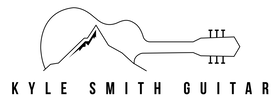 When I started learning jazz guitar, I pretty much only worked on learning chords. I had a great teacher who had a pretty “old school” approach. Lots of exercises with different chords, finding them all over the neck so you always had an option for your next chord. I got really good at sight reading chords - and the kind of charts you would get in a jazz band. Traditional Comping ApproachHe was also very traditional in his approach to accompaniment, which is the guitar players main job in a jazz band - “4 to a bar” playing where you strum once on each beat. This worked great for me for a long time. I mostly played guitar in jazz band, so that style worked perfectly in most of the situations I encountered. I started getting hired for groups around town, playing for weddings, events, and pit orchestras for musical productions as a high school kid. Eventually I Needed Something DifferentOnce I got to college though, I started encountering situations where this 4 to a bar style accompaniment wasn’t working as well. And as I listened to a wider variety of jazz music, I noticed that the guitar was sometimes doing all kinds of different rhythm patterns behind melodies and soloists. I Learned A Lot About Different Comping StylesOver time, I worked with several different jazz guitar teachers. I would book a lesson with anyone I could as they came through town, or sometimes I would travel across the state to meet with a great teacher for an hour. Through these teachers and my university professors, I was able to identify some general rules about accompaniment that helped me improve my playing, and help me sound better in a wider range of jazz styles. Now I was getting hired by jazz groups in my new local area, which was much more competitive than where I grew up. I even won a couple of guitar jobs over older, more experienced guitar players - partially because of my comping ability. Over Time, I Figured Out What Really WorksAs a guitar teacher, I’ve worked with students of a wide range of ability levels - from kids starting out in jazz band to serious high school and college age students to adults who want to learn jazz guitar for fun. Over the years I’ve found 3 basic comping rhythms that work well as an entry point for most players. By mastering these three patterns and learning how to switch between them, you’ll have a good foundation for becoming the kind of jazz guitar player that people want to play with and listen to. Note - A lot goes in to good accompaniment skills, and just learning one or two patterns isn’t necessarily going to cut it. But that doesn’t mean you have to learn thousands of rhythm patterns either. What You'll LearnIn this lesson you’ll learn 3 important comping rhythms - Freddie Green, The Charleston, and the Reverse Charleston. More importantly, you’ll learn how to piece these rhythms together in a way that will sound good and support a melody or soloist. Comping is an essential jazz guitar skill, and it’s one of the most important parts of playing jazz guitar with other people. It is also a very overlooked area of many guitarists playing. If you take the time to develop your comping skills, it can set you apart as a jazz guitarist, and help you get more opportunities to play with better groups. Comping RhythmsComping is one of the most important things we do in many playing situations. Being able to accompany and back up a soloist in a musical way is an essential skill that you need to develop. Here are the 3 comping rhythms you need to get started: Freddie Green StylePlaying in this style is a staple of traditional big band guitar playing, especially in the style of Count Basie. This comping rhythm gets its name from Count Basie’s guitarist, Freddie Green. Although it was popularized in the big band style, this pattern is useful in small group and duo playing, as well. The CharlestonThe Charleston rhythm is a logical “next step” for students looking to break away from the Freddie Green style. Be careful not to overuse this rhythm - on its own, it can get old really quickly. The Reverse CharlestonThe “Reverse Charleston” rhythm is simply a reversal of the Charleston rhythm. These Rhythms work well together one right after another: 1 measure of Charleston, 1 measure of Reverse Charleston. This will help add another level of interest in your comping. Mix And Match RhythmsOnce you’re comfortable with all 3 of these comping rhythms, you can mix and match them to create some of your own rhythm patterns. Just be sure to use your ears and do your best to make your accompaniment fit the music going on around you. Mix And Match Example 1Mix And Match Example 2Things To Think AboutGood comping skills require having good rhythmic skills, a sense of time, and maybe most importantly, good listening skills. The rhythms and ideas we talked about in this lesson are a good starting point, but good jazz guitar comping is something that can always be worked on and improved. Listening to and observing great accompanists on guitar, piano, or organ is going to be an important step in further developing your skills. The specific skills we learned in this lesson are:
Always use your ears, and try your best to make good stylistic decisions when using these rhythm patterns. When in doubt, ask your band director or guitar teacher. You can also ask me for help. Keep practicing, and let me know how it's going! Jazz Guitar LessonsIf you really want to improve your jazz guitar skills, taking lessons is one of the best ways to get started or start making progress again. There are 2 ways I can help you with jazz guitar lessons: Both lesson formats provide one on one instruction and coaching so you can learn the skills that will make the biggest impact on your jazz guitar playing.
Contact me today to find out how I can help you with jazz guitar lessons!
0 Comments
Your comment will be posted after it is approved.
Leave a Reply. |






